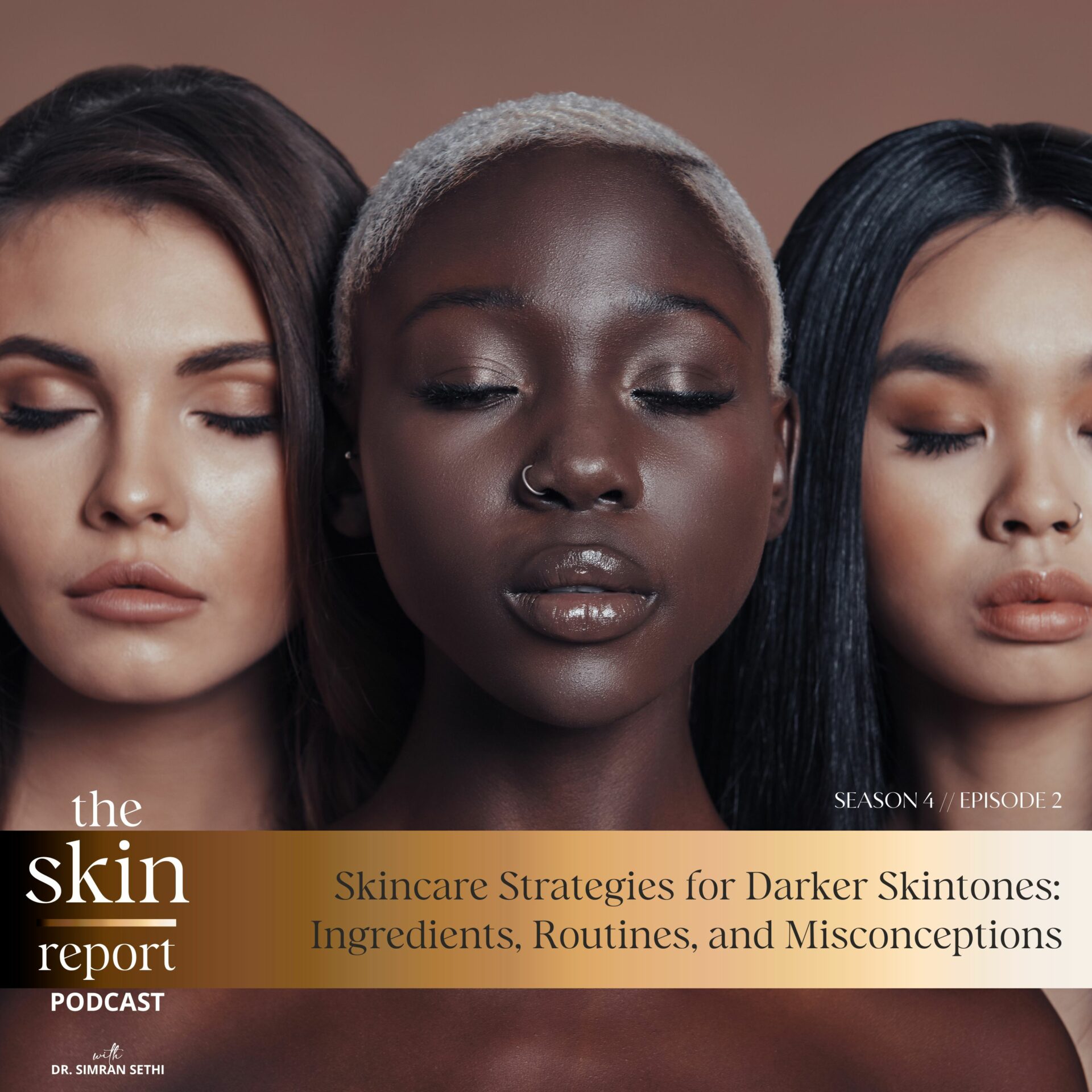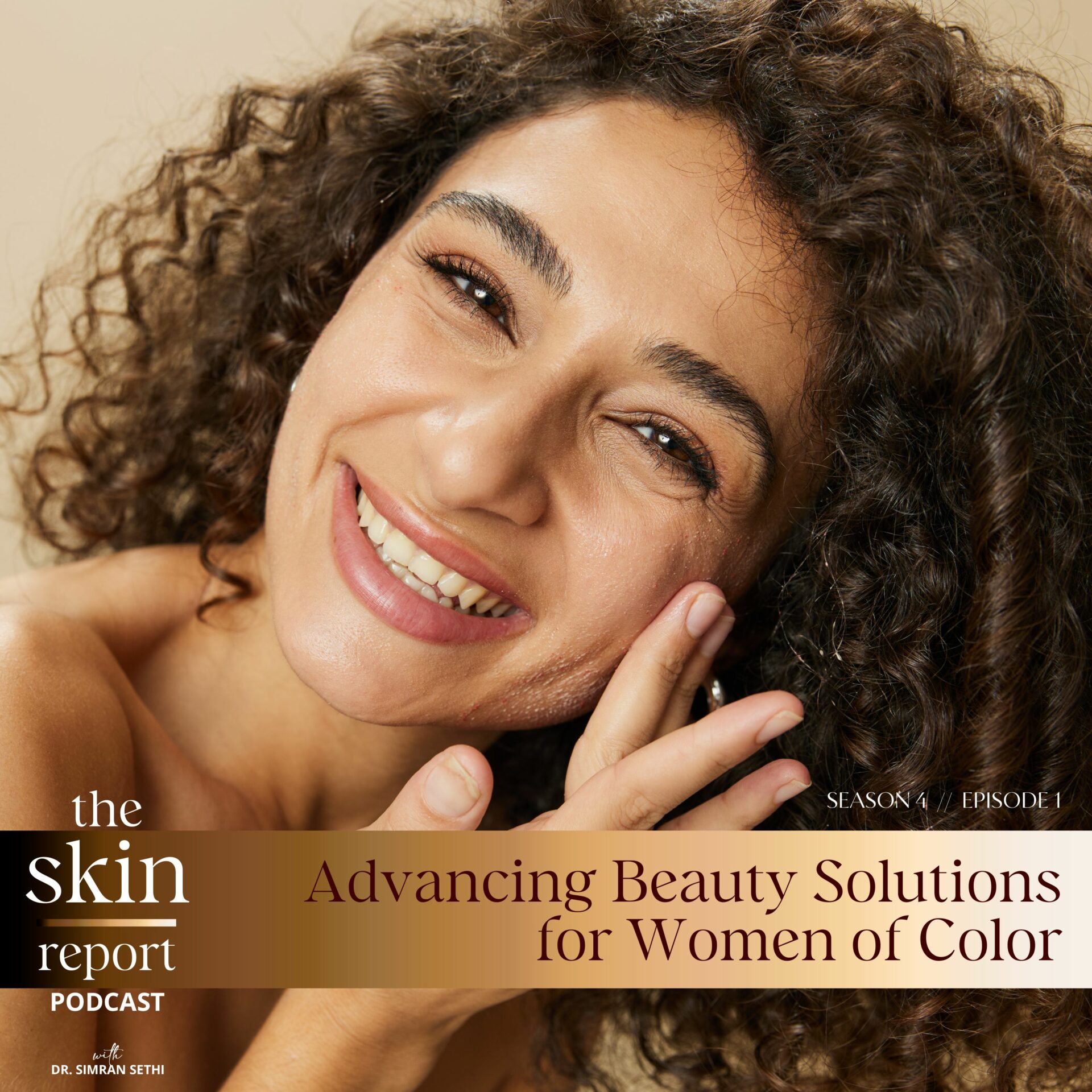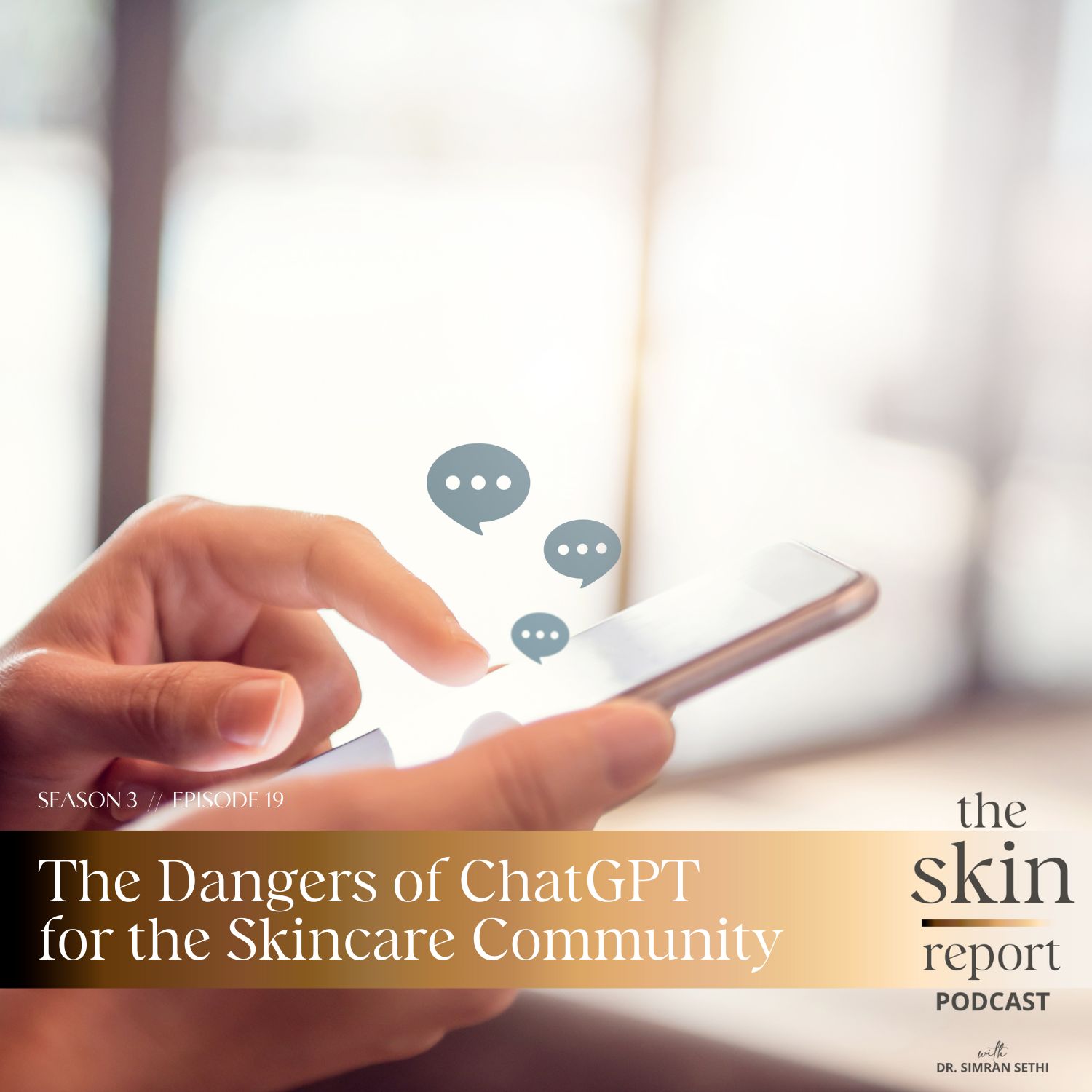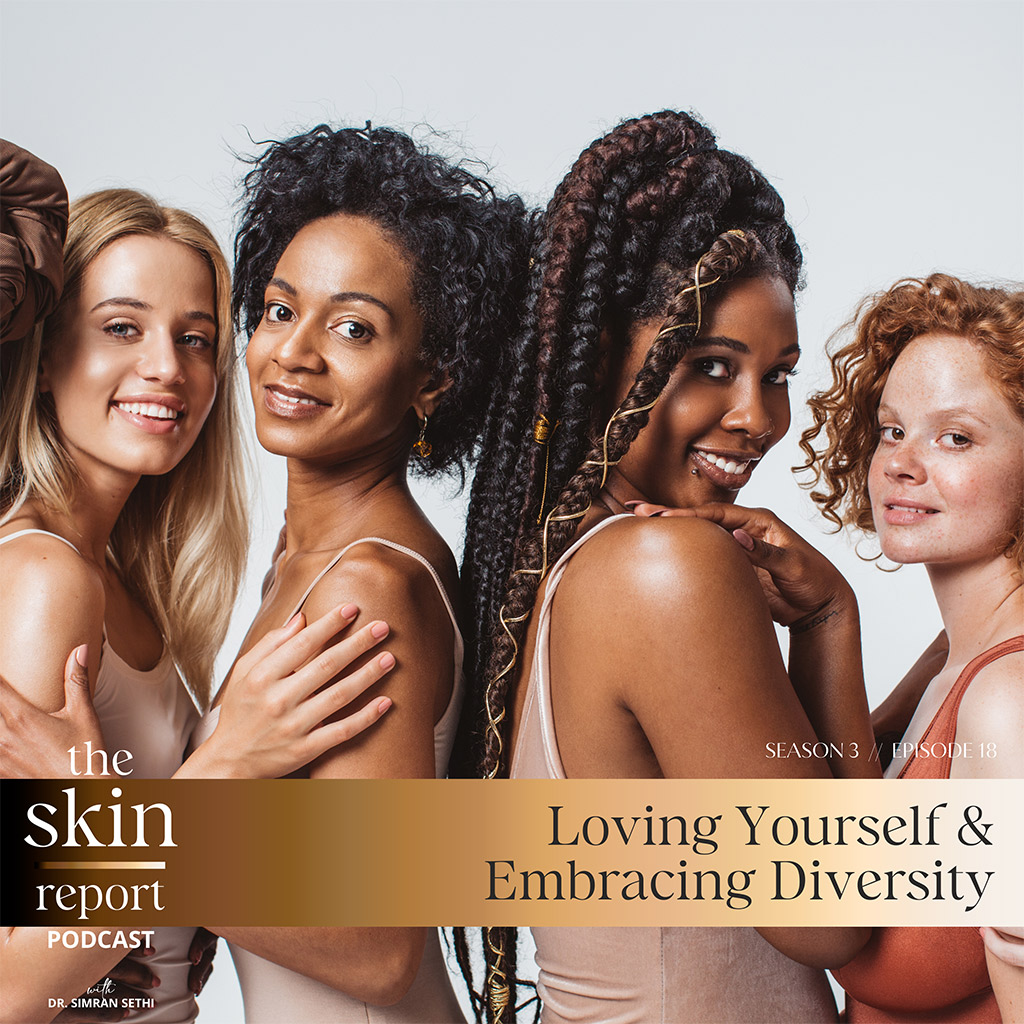Skin type and skin tone are important factors to consider when choosing the ideal treatment plan for your skin. After all, if you don’t know your skin type, how could you possibly know how to take care of it? Skin treatments can have different effects on skin types and tones, and these details should always be taken into account when determining healthy skin solutions. That said, if you are unaware of your skin’s type and tone, you may be buying ingredients that actively harm your skin and exaggerate your skin’s conditions.
Skin Report is a podcast created to educate listeners on methods to improve skin health for people of all ethnicities and ages. In this episode, host Dr. Sethi discusses why skin type and tone are vital for determining proper skin treatments. Unfortunately, skin type can change with age, and skin tone is often overlooked, which can complicate the process of finding solutions for skin conditions. Dr. Sethi explains the difference between skin type and tone, highlights the importance of knowing your skin tone, and shares methods for determining one’s skin tone and type. Finally, she shares her thoughts on how listeners can access the best treatments for their skin and use their power as consumers to support businesses created by and for women of color.
Follow and DM a question for Dr. Sethi to answer on The Skin Report Podcast: RenewMD
Beauty Instagram: https://www.instagram.com/renewmd_beauty/
RenewMD Beauty Medical Spas, California: https://renewmdwellness.com/
This transcript was exported on Jun 14, 2022 -view latest version here.
The Skin Report Episode 5
Skin care can sometimes feel overwhelming. Whether it’s finding the right products, ingredients, or treatments, there’s a lot out there, but not always for women of color. That’s why I set out to educate myself and others so that we can all feel beautifulin our skin.
Hello, and welcome to The Skin Report. I’m Dr. Simran Sethi, an internal medicine doctor, mom of three and CEO and founder of RenewMD Medical Spas and Skin by Dr. Sethi. Today I want to talk about skin type versus skin tone, how to categorizeyour skin, the Fitzpatrick scale, and more. By understanding our own skin, we will better understand its individual needs and therefore we’ll be more capable in providing them.
I want to start today’s episode off outlining the difference between skin typeand skin tone. Although these are two separate characteristics, they often get confused and it’s no wonder, they do sound similar. And the skin care industry uses skin tone and skin type interchangeably even though they are very different, but that’s why I’m here. I want to create a judgment-free skin care space with the help of my education and medical experience, especially in the context of not only but skin tone.
So let’s dive into skin type versus skin tone. First, let’s tackle skin type. Skin type refers to how much or little oil or sebum the skin produces. We spoke about sebum in Episode 3, when we discuss skin care approaches for every age. If you’d like to hear more about the role of sebum and how to prioritize skin care for your age, take a listento Episode 3 of The Skin Report.
In this episode, we’re going to be chatting about how sebum relates to skin type. When referring to skin type, we are talking about whether the skin is oily, dry, combination, or normal. It’s also important to remember that your skin type can change with age and this is simply a natural occurrence of aging. In your younger years generally between the ages of 15 to 20, we tend to have and produce more oil in our skin.
But as we age, especially when women get closer to menopause, skin can become dry and the skin cell turnover rate slows down, which again is a natural occurrence. So is there a more common skin type? Overall, most people fall into the combination skin category. This means they tend to have an oily forehead, noseand chin aka the T-zone while their cheeks are usually dry or normal.
While we don’t have exact numbers, we do know that Americans in particular struggle to understand their skin type. A recent survey skin survey found that up to 80% of Americans wash their face incorrectly or are simply uninformed about proper skin cleansing methods. The survey found that consumers felt uninformed about proper skin cleansing methods. The majority of respondents had no idea what ingredients to look for and why those ingredients are important.
While 97% of people in this same survey study reported that they know their skin type, they still were not informed of proper product use. For example, almost 40% of those with dry skin pinpointed benzoyl peroxide as their most essential ingredient for their facial cleanser, an ingredient that actually dries out skin even more.
Skin type education in my clinical experience is at the heart of the issue of improper skin care. Because if you don’t know your skin type, how could you possibly know how to take care of it? If you don’t know if your skin is oily, combination, dry or normal, you may put yourself in a vicious cycle of over drying or overproducing oil in your skin. In fact, you may be buying ingredients that actively harm your skinand exaggerate skin conditions.When we return, we will go over ways to determine your skin type, as well as your skin tone.
As discussed, knowing your skin type is important for picking the best skin care routine for you. Without having this foundation of knowledge, you may be causing more harm than good. You could be stripping already dry skin or clogging up oily skin. So before you do or buy anything for your skin, toners, moisturizers, makeup, be sure to properly determine your skin type first.
There are several ways you can do this at home for free. First, you can observe how your skin currently is. Does it feel tight and flaky throughout the day? If so, you may have dry skin. Are your cheeks dry, but your nose, chin and forehead shiny? You most likelyhave combination skin. If you are prone to breakouts and feel like your whole face is shiny, you most likely have oily skin. All of this being said, it can be truly difficult to look at your skin objectively, especially if you already have product on.
That’s why I suggest the bare face method. With this approach, you’ll want wash your face with a gentle cleanser and pat dry. Don’t put anything on your skin for at least 30 minutes, then observe your face and its shine. [inaudible 00:05:52] notice where the shine may be, if any. Is it in your T-zone, cheeks or nowhere at all? Leaving your skin bear for an additional 30 minutes will also give you time to notice how your skin feels all by itself.
If it feels tight, flaky, itchy, then you most likely have dry skin. If you have oily, your skin may feel heavy and greasy all over without any areas of itching or tightness. There are also other ways of determining your skin type. There are online assessments and consultations with someone like myself who cannot only tell you what skin type you have, but what active ingredients to look for and what products will have them.
Think of your skin type as your base layer. Anything you put on your skin will interact with your base layer. We will definitely be touching on skin type often as it relates to skin care. So be sure to subscribe to the podcast to hear updates on how to treat your skin type.When we return, I want to dive into skin tone, something equally as important as skin type, yet often overlooked.
If you’ve shopped at any drugstore cosmetics or skin care retailer, you will see that so many brands make different products for oily, combination, dry and normal skin types. As I’ve said, this is because different people have naturally different levels of sebum resultingin a face that experiences dryness, oiliness or both therefore, it’s important to match the right ingredients to their condition.
Our skin tone is another extremely important characteristic and requires its own attention as well. Before we go any further,I would like to define skin tone via the Fitzpatrick’s skin scale. Skin tone refers to how much melanin is in the skin and is classified based on the Fitzpatrick scale. The Fitzpatrick scale was introduced by Thomas B. Fitzpatrick in 1975 as the way of classifying how different types of skin would respond to UV light exposure. It is universally used in clinical dermatology when assessing safety of skin care products and treatments.
Now, bear with me for a moment as the language can get confusing. The Fitzpatrick scale categorizes skin into six different types, types one through six. This is really a misnomer and should be better classified as tones one through six. For the purposes of our discussion, I’m going refer the Fitzpatrick scale as skin types to stay consistent. So when I say type one or type six, I’m referring to the Fitzpatrick scale’s categories, not how oily or dry your skin is.
Another clarification I want to make. If you Google the Fitzpatrick scale, you’ll see images that contain six types ofskin tones. However, the Fitzpatrick scale does not distinguish six different types of skin color, rather it’s based on how your skin type reacts to sun exposure. This means that someone with skin type one will burn after spending a short amount of time in the sun and is also less likely to tan. More melanated skin types like skin type four to six will likely not burn with sun exposure, but will tan easily.
Skin tone is often overlooked or disregard it. Until I started practicing aesthetic medicine, even Ididn’t realize the importance of paying equal attention to both skin type and tone. And why is that? Why is skin tone just as important as skin type when it comes to treatments? Let’s dive into a scenario. If we compare two teenagers with acne, one with alighter skin tone say skin type two, and the other with a darker skin tone like skin type four, both will start breaking out by using traditional acne-suppressing skin care. But these products usually leave skin very dry.
However, this dryness will impact the teenagers differently. The teenager with skin type two may have dry skin, but it will be clear and their skin tone will still appear even. The teenager with a darker skin tone will no longer have breakouts, but their skin will have dark spots wherevertheir acne used to be. In Episode 2 of The Skin Report, we discussed how melanin impacts the skin, especially when it comes to skin insults, such as acne, sun exposure, or sensitivity to products.
More melanated skin types will produce more pigment in response to these skin insults. Therefore, as a response to acne, the teenager with the darker skin tone will be left with these dark spots. Because of the dryness from the acne products, these spots will get even darker and their overall skin tone will be uneven and dull. All that being said, should these two different skin tones with the same skin types be treated the same way? Definitely not.
After working with so many skin tones and types, I’ve learned that skin tone should always be factored into the equation when finding skin solutions for skin type. When we return, we’ll take a step back and look at how skin tone is received by the beauty industry as a whole, and what we can do to navigate this.
As we discussed, many products specifies skin type that itsgeared towards, but few address different skin tones. There are some large skin care companies that are just starting to offer a small array of products for darker skin tones. What I find interesting is that this approach lumps all darker skin tones into a general skin type and does not specifically address oily, dry or combination skin in darker skin tones as if everyone with a darker skin tone has just one type of skin. This is simply not true. And it is a clear sign that the skin care and aesthetics industry has a long way to go before skin of color has the same number of solutions as lighter skin tones have today.
In our very first episode, we discussed just this, how the skin care industry has often excluded women of color. From our research and our own personal experiences, we have found that the makeup industry has made some strides for makeup options for all skin tones, but skin care is still decades behind. Skin of color needs dedicated and specific solutions for acne, anti-aging, brightening and dry skin. As a skin care brand, you cannot possibly deliver solutions for complex skin issues with only a handful of products that make big claims.
In fact, I’ll be honest. As a person of color, I find this almost insulting because it is just an attempt by companies to move with the times and use optics to show inclusivity when true inclusivity requires research and development, and a lot more commitment than using models of color in their ads or slapping on a four darker skin tone label on a few products. Sowhat can we do? As customers who want the best for their skin, we can use our consumer power to help us find and support businesses by women of color or for women of color.
Not only are you more likely to find products that work for you and your skin toneand type, but you will also be boosting up that brand. When looking for skin care or makeup products for your skin tone, look at how the brands represent your skin tone or just a diversity of skin tones in their clinical studies, imagery, brand story, and clinical philosophy.
Even the number of products developed for your skin tone shows the true level of commitment the brand has made to your unique needs, instead of considering your darker skin tone as just an afterthought. All these factors have been incredibly important to me when developing my own skin care line, because I wanted to bring to market solutions for skin of color developed after years of clinical experience, and honestly, trial and error because there is such a lack of research dedicated to our darker skin tones.
If you would like to find more information on your skin type and tone or to find out more products, approaches or even procedures for your skin color, you can check out my website, renewmdwellness.com. If you have a skin care question, please DM me @renewmd_beauty and I will answer it in our next episode. Thanks for listening and until next time, love the skin you’re in and celebrate your beauty.
Transcript by Rev.com











